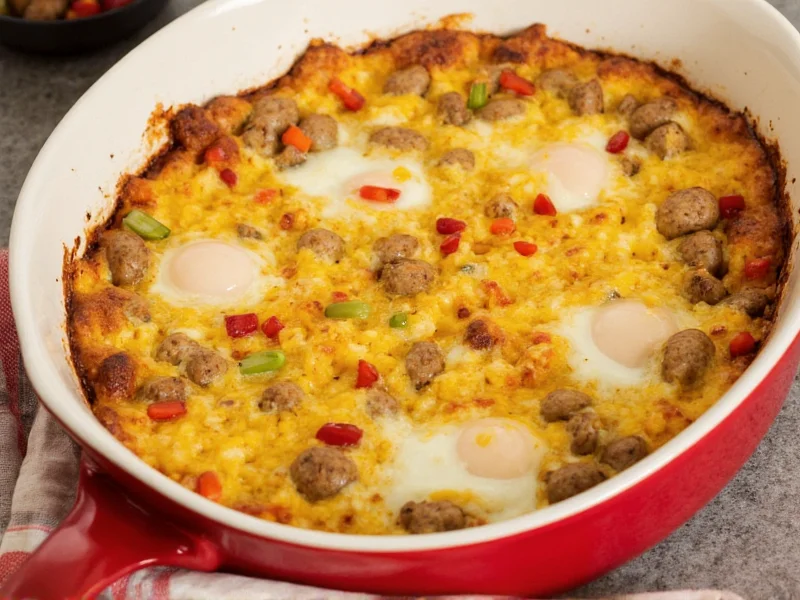An egg and sausage casserole stands as one of the most practical breakfast solutions for busy households. This versatile dish transforms simple pantry staples into a satisfying meal that can feed a crowd with minimal active preparation time. Unlike standard frittatas or quiches, casseroles bake in a deep dish, creating generous portions ideal for weekend brunches or weekday meal prep.
Why This Recipe Works
The magic of a perfect egg and sausage casserole lies in its balance of protein, fat, and moisture. Sausage provides savory depth while eggs create the structural base. The addition of milk or cream prevents rubbery texture by slowing protein coagulation during baking. Cheese not only adds flavor but also creates a protective layer that keeps the eggs tender.
Ingredient Selection Guide
Choosing quality components makes the difference between an average casserole and an exceptional one. For the best sausage for egg casserole, select fresh breakfast sausage with 75–80% lean content. Too lean and the dish dries out; too fatty and it becomes greasy. Avoid pre-cooked or heavily smoked varieties which can overpower other flavors.
| Ingredient | Recommended Amount | Key Purpose |
|---|---|---|
| Breakfast sausage | 1 pound (450g) | Provides savory base and protein |
| Large eggs | 8 whole eggs | Creates the custard structure |
| Milk or cream | 1 cup (240ml) | Prevents rubbery texture |
| Shredded cheese | 2 cups (225g) | Adds richness and moisture barrier |
| Vegetables | 1–2 cups (150–300g) | Provides texture and flavor complexity |
Step-by-Step Preparation
Follow these professional kitchen techniques for flawless results every time:
- Brown the sausage properly - Cook in a skillet over medium heat until fully browned but not crispy. Drain excess fat but retain about 1 tablespoon for flavor.
- Prep vegetables correctly - Sauté onions, peppers, or mushrooms until softened. Raw vegetables release too much moisture during baking.
- Whisk eggs thoroughly - Combine eggs, milk, salt, and pepper until completely uniform. Small bubbles indicate proper aeration.
- Layer strategically - Place half the sausage and vegetables in the baking dish first, then pour half the egg mixture, repeat layers, and top with cheese.
- Bake at precise temperature - 350°F (175°C) for 35–45 minutes. The center should register 160°F on an instant-read thermometer.
Avoid These Common Mistakes
Even experienced cooks make these egg casserole errors:
- Overbaking - Remove the casserole when the center still has a slight jiggle. Residual heat continues cooking the eggs.
- Skipping the resting period - Allow 10–15 minutes after baking for the structure to set before slicing.
- Using cold ingredients - Bring eggs and milk to room temperature first for even cooking.
- Overloading vegetables - Excess moisture from vegetables creates a soggy casserole. Stick to 2 cups maximum for a standard 9x13 dish.
Variations for Dietary Needs
Adapt this easy egg and sausage casserole recipe for various preferences:
- Gluten free egg and sausage casserole - Omit bread cubes and increase vegetables by 50%. Add 1/4 cup almond flour to absorb excess moisture.
- Vegetarian sausage casserole substitution - Replace sausage with 1.5 cups cooked lentils and 1/2 cup chopped mushrooms for umami depth.
- Low-carb version - Skip bread components entirely and add 1/2 cup grated zucchini (squeezed dry) for texture.
- Dairy-free option - Substitute milk with unsweetened almond milk and omit cheese or use nutritional yeast for cheesy flavor.
Make-Ahead and Storage Tips
This dish shines as a make ahead breakfast casserole. Assemble completely, cover tightly, and refrigerate for up to 24 hours before baking. For longer storage, freeze the unbaked casserole for up to 3 months. Thaw overnight in the refrigerator before baking.
For reheating egg casserole leftovers, cover individual portions with a damp paper towel and microwave at 50% power for 2–3 minutes. This gentle method prevents rubbery texture. Alternatively, reheat in a 325°F oven for 15–20 minutes until warmed through.
Frequently Asked Questions
How long does egg casserole last in the refrigerator?
Properly stored in an airtight container, egg and sausage casserole stays fresh for 3–4 days in the refrigerator. Always reheat to an internal temperature of 165°F before serving.
Can I use frozen vegetables in my sausage casserole?
Yes, but you must thaw and thoroughly drain frozen vegetables first. Excess moisture from frozen vegetables creates a watery casserole. Pat dry with paper towels before adding to the mixture.
Why did my egg casserole turn out watery?
A watery casserole typically results from either undercooked vegetables releasing moisture during baking or using too many high-moisture ingredients. Always sauté vegetables until softened and limit total vegetable content to 2 cups for a standard recipe.
What's the ideal baking dish size for egg casserole?
A 9x13 inch baking dish works best for standard egg and sausage casserole recipes serving 6–8 people. For smaller batches, use an 8x8 inch dish and reduce baking time by 5–10 minutes. Glass or ceramic dishes provide more even heating than metal.
Can I add bread to my egg and sausage casserole?
Absolutely. For a strata-style casserole, add 3–4 cups of cubed bread (stale works best). Layer bread between sausage and egg mixtures, ensuring all bread gets saturated. Increase baking time by 5–10 minutes to accommodate the additional moisture absorption.











 浙公网安备
33010002000092号
浙公网安备
33010002000092号 浙B2-20120091-4
浙B2-20120091-4